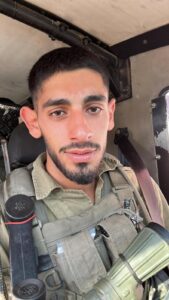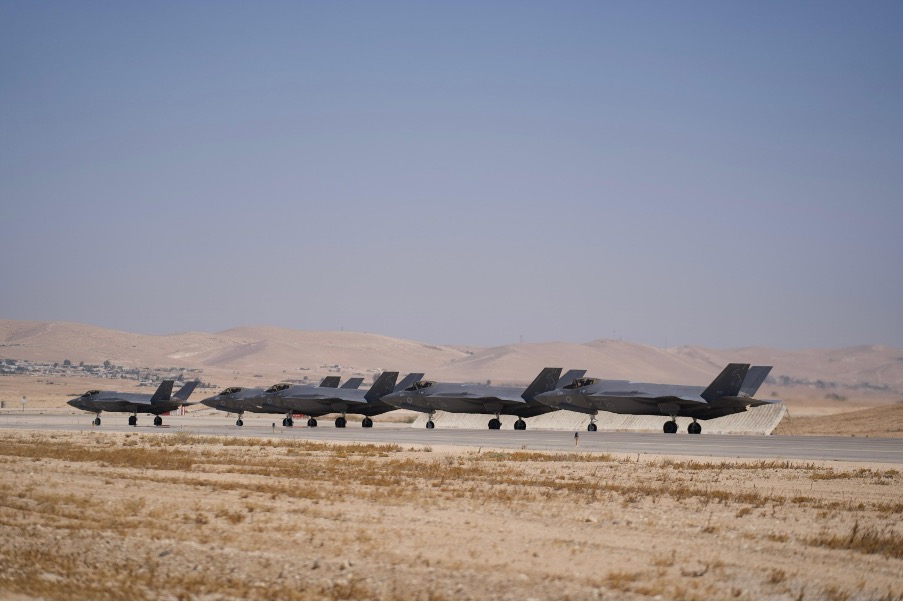
Overview
- Israel launched operation “Rising Lions” to dismantle Iran’s nuclear and ballistic missile programs. It used over 200 Israeli aircrafts in 5 separate waves attacking over 100 targets including top IRGC personnel, military sites and nuclear enrichment sites.
- Iran retaliated with over 100 ballistic missiles with some penetrating Israel’s defenses causing 13 casualties and dozens of injured civilians.
- Hezbollah announced it would not join the war against Israel demonstrating a dramatic shift in the balance of power.
- Israel carried out its tenth attack against the Houthis, and for the first time, this was a naval strike
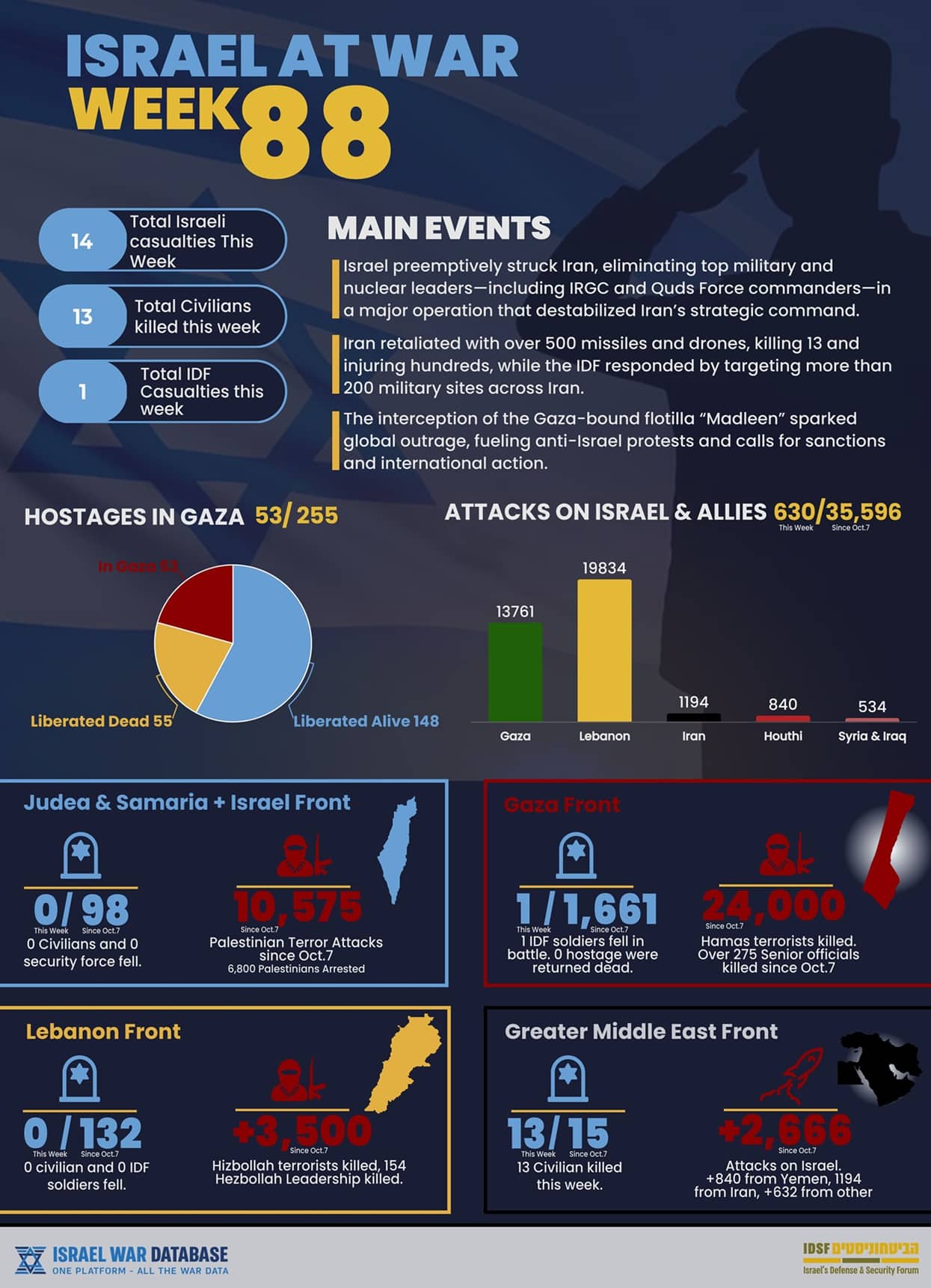
Iran
Operation “Am KeLavi” (“Rising Lion”)
- Operation “Am KeLavi” began around 3:00 AM on Friday June 13 (Israel time), with the explicit objective of disrupting and severely damaging Iran’s nuclear program and military command structure.This was not a limited raid but a broad, multi-stage strike, planned for months and executed in total surprise, utilizing Israel’s far-reaching airpower and special operations. According to official reports, over 200 Israeli Air Force (IAF) fighter jets crossed more than 1,500 kilometers of airspace—including Syrian and Iraqi skies—reaching deep into western Iran. In just a few hours, these jets conducted at least five waves of attacks, targeting more than 100 distinct sites across five major provinces.
- The operational focus was the destruction of both “hardware” (nuclear and missile sites) and “software” (leadership and command structures), targeting both the physical infrastructure and the top echelons of Iran’s military and nuclear establishments.The IDF spokesperson’s illustrated maps identified five main provinces: Tehran, Isfahan, Tabriz, Khuzestan, and Ilam. In Tehran, the targets were senior IRGC generals and top nuclear scientists; Isfahan’s sites included the central facilities for uranium enrichment; Tabriz, Khuzestan, and Ilam (all along Iran’s western frontier) were struck for their concentrations of missile launchers, air defense batteries, and logistical infrastructure.
- Prime Minister Netanyahu made a public statement around 4:20 AM, at the peak of the operation, outlining its main goals: the destruction of Iran’s nuclear infrastructure, ballistic missile factories, and much of its military capability.He revealed that Iran was in the process of assembling nine atomic bombs, and intended to build 10,000 ballistic missiles—some with one-ton warheads—within the next three years. Netanyahu concluded by warning that all of Israel’s military gains could be reversed if Iran achieved nuclear weapons status, framing the operation as a war for Israel’s very survival.
Mossad Special Operations and Combined Assault
- A major innovation in this operation was the Mossad’s role in orchestrating deep-cover special forces actions inside Iran, which operated in parallel and in coordination with the air assault.Mossad units, whose activities were later publicized, managed to infiltrate Iran and deploy advanced drone and missile systems atop remote mountains, setting ambushes for Iranian air defense sites. Their missions included destroying radar stations, launching platforms, and missile containers, severely degrading Iran’s capacity to fire back immediately at Israel. Mossad operatives built a secret base for explosive-laden drones deep inside Iran, specifically near Tehran. These drones were pre-positioned to target Iranian air defenses and missile launch sites, such as the Esfajabad base. The base could be activated remotely, enabling drone attacks without the need for Mossad personnel to be physically present at the time of the operation.
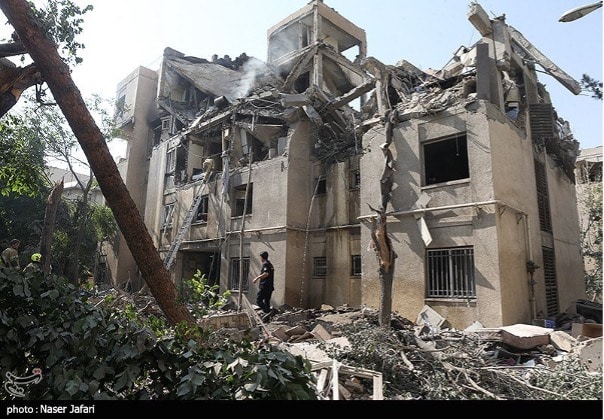
- In addition to direct sabotage, Mossad operations included supplying Israeli forces with real-time intelligence about Iranian air defense layouts, convoys, and command bunkers.As a result, the IAF was able to strike successive waves with high precision, focusing firepower where it mattered most, and adjusting mid-operation to exploit the chaos inside Iran’s command ranks. Video evidence later released clearly showed the destruction of sophisticated Iranian air defense sites, including at least one S-300 battery—an elite component of Iran’s strategic deterrent.
- High-precision guided weapons and explosive devices were concealed inside civilian trucks and other vehicles throughout Iran. These weapons were remotely detonated during the operation to destroy air defense assets and missile convoys. According to Israeli sources, targeting trucks transporting missiles meant that each truck destroyed resulted in the elimination of several operational missiles, amplifying the impact on Iran’s ability to retaliate. The operation employed “Trojan Horse” tactics, involvingyears of infiltration and use of advanced technology and human assets to evade Iranian counterintelligence. The highest level of secrecy was maintained by briefing Israel’s security cabinet only on unrelated matters, with the real nature of the operation concealed even from top officials until just before its launch. Only a small inner circle (including Netanyahu, Mossad chief David Barnea, and Minister Ron Dermer) was fully briefed.
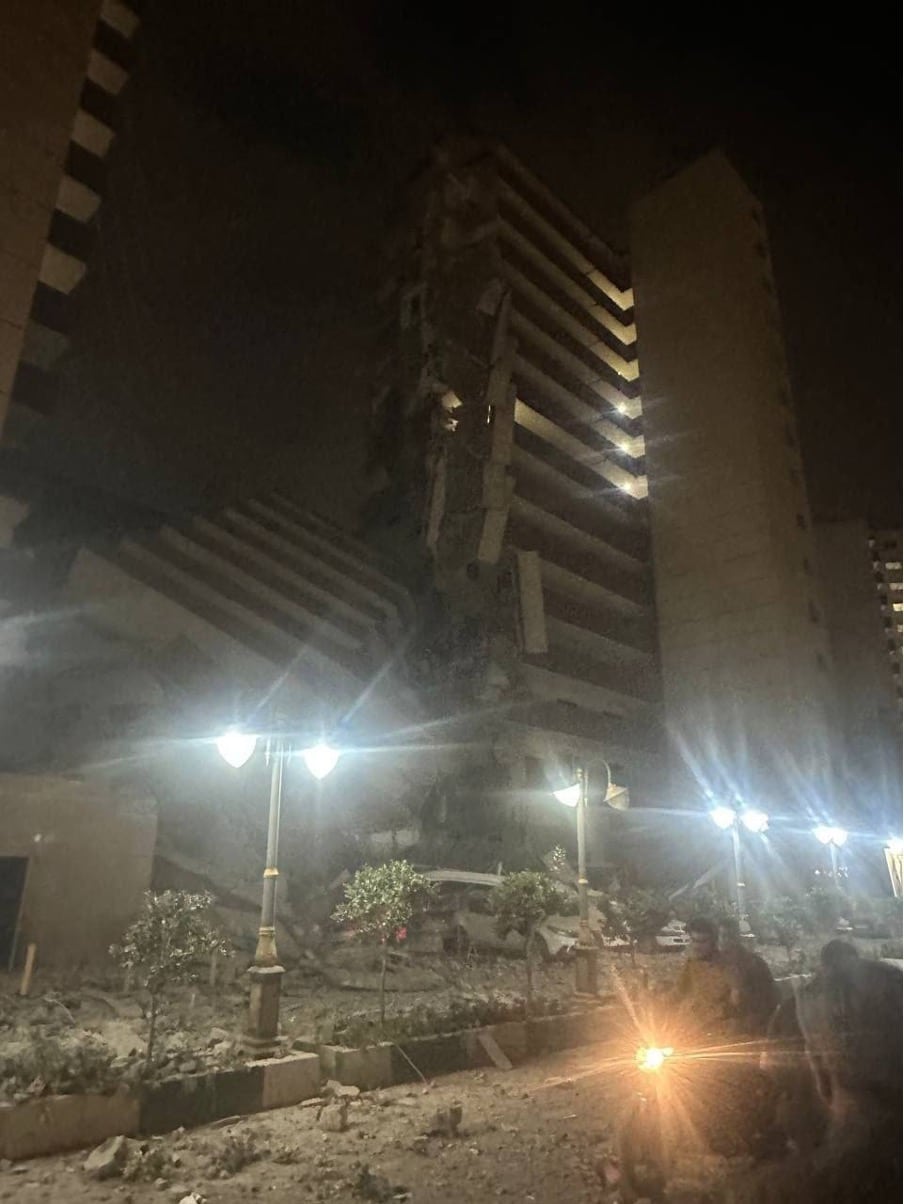
Key Sites and Infrastructure Destroyed
- The Natanz uranium enrichment facility—the backbone of Iran’s nuclear ambitions—sustained particularly severe damage.Iran’s Atomic Energy Organization admitted as much, while the head of the IAEA, Rafael Grossi, personally informed Israeli President Herzog that the site was “critically damaged,” prompting immediate inspection for radioactive leaks. According to IDF statements, the attack targeted the underground enrichment hall, several stories of centrifuge arrays, and the associated infrastructure for nuclear fuel preparation. The assault was directed not only at aboveground structures but also at the vast, hardened underground complex. Additionally, peripheral sites such as the control center and power transformers were struck, further crippling operations at Natanz. A nuclear enrichment facility at Fordo (100 km southeast of Tehran) was reportedly hit. The IAEA confirmed there was no increase in radiation levels at Natanz, showing the precision of the strikes. Iran’s Atomic Energy Organization claimed there were no casualties at Natanz, though structural damage was acknowledged.
- Other targets included Iran’s strategic missile program and UAV factories.In western Iran, Israeli jets struck launch complexes housing at least 13 readied missile launchers within containers, as well as two major missile depots. These facilities were considered capable of threatening not only Israel but also much of the Middle East and even southern Europe. In Tabriz, Israeli attacks were reported on plants manufacturing solid propellant for Iran’s longer-range ballistic missiles, representing a critical blow to Iran’s ability to maintain and expand its missile arsenal. According to multiple sources, Israel achieved what its planners call “blue skies” over much of western Iran—meaning effective destruction or suppression of the entire local air defense network, opening a path for future raids.
Leadership Decapitation: Names and Roles of Confirmed Killed Officials
- Major General Hossein Salami, Commander-in-Chief of the IRGC since 2019, was killed in the attack. Salami was one of Iran’s most influential and vocal military leaders, responsible for crafting and executing anti-Israel military policy and overseeing missile and drone campaigns across the region. He was instrumental in shaping Iran’s strategic doctrine, and his loss leaves a significant leadership vacuum at the very top of the IRGC.
- Major General Mohammad Bagheri, Chief of Staff of Iran’s Armed Forces since 2016, was also eliminated.Bagheri coordinated Iran’s entire military establishment, ensuring the cooperation of the army, IRGC, and Iran’s missile and air defense divisions. His influence extended into Iran’s overseas military partnerships, especially in Syria, and he spearheaded the modernization of Iran’s missile systems. The elimination of Bagheri represents a major blow to the planning and execution of Iranian military policy.
- Brigadier General Amir Ali Hajizadeh, Commander of the IRGC Aerospace Force since 2009, was killed in the raid.Hajizadeh oversaw all of Iran’s missile and drone forces, including both offensive and defensive operations. He was previously known for ordering the downing of a Ukrainian civilian airliner and for repeated public threats against Israel and Western powers. His death is a devastating loss to Iran’s missile command and its ability to coordinate aerial retaliation.
- Brigadier General Gholam Ali Rashid, Head of the IRGC’s Khatam-al-Anbiya Central Headquarters, was confirmed killed.Rashid’s headquarters coordinated all IRGC operations nationwide, functioning as a strategic “brain” for Iran’s unified military doctrine. The removal of Rashid severs a central node in Iran’s command and control structure, complicating its ability to wage war or launch a coherent retaliation.
- Davoud Shaykhian, Commander of the IRGC Air Defense Unit, was also killed.Shaykhian was responsible for managing and deploying Iran’s ground-to-air missile systems, vital for defending sensitive nuclear and military sites from airstrikes. With his loss, Iran’s air defense suffered not only material damage but also a leadership crisis at a critical operational level.
- Taher Pour, Commander of the IRGC Unmanned Aerial (Drone) Forces, died in the strike.Pour oversaw both the development and fielding of Iran’s drone capabilities for intelligence gathering and strike missions. As Iran has increasingly relied on drones for both direct attacks and proxy warfare, his loss is a setback to one of the most rapidly advancing arms of the Iranian military.
- Ali Shamkhani, advisor to the Supreme Leader and former Secretary of the Supreme National Security Council, was fatally wounded and later succumbed to his wounds.Shamkhani was a long-standing military and security strategist, previously serving as Defense Minister and Navy Commander. He provided continuity and strategic advice at the very highest echelons of Iran’s regime, and his death represents a loss of both institutional memory and real-time crisis management.
- Major General Gholamreza Mehrabi, Deputy Head of Intelligence for the Armed Forces General Staff, was killed.Mehrabi was integral in both the planning and implementation of military intelligence operations, and his loss disrupts Iranian efforts to monitor, anticipate, and counter Israeli actions.
- Major General Mehdi Rabbani, Deputy Head of Operations for the Armed Forces General Staff, was eliminated.Rabbani was responsible for military operational planning at a strategic level, and his removal further destabilizes Iran’s command structure during this critical period.
- Nuclear scientists Fereydoun Abbasi and Mohammad Mehdi Tehranchi were among those killed.Abbasi, a former head of Iran’s Atomic Energy Organization and a key architect of Iran’s nuclear efforts, and Tehranchi, head of Islamic Azad University in Tehran, were leading figures in advancing Iran’s nuclear research and technology. Their deaths deal a direct blow to Iran’s expertise and continuity in nuclear weapons development.
- According to reliable reports, at least 20 senior Iranian commanders and numerous key officers were killed overall.This represents a “decapitation strike” against Iran’s leadership, affecting not just military readiness but strategic and scientific capacity as well.
Iranian Response and Immediate Regional Fallout
- Iran attempted an immediate, if limited, response by launching UAVs toward Israeli territory, specifically the Eilat area, southern Syria, and the Lebanese coast.The attack was coordinated but ultimately unsuccessful, as all UAVs were intercepted by the Israeli and Jordanian air forces. The drones took a circuitous path, likely in an attempt to evade Israel’s missile defenses, but this maneuver failed.
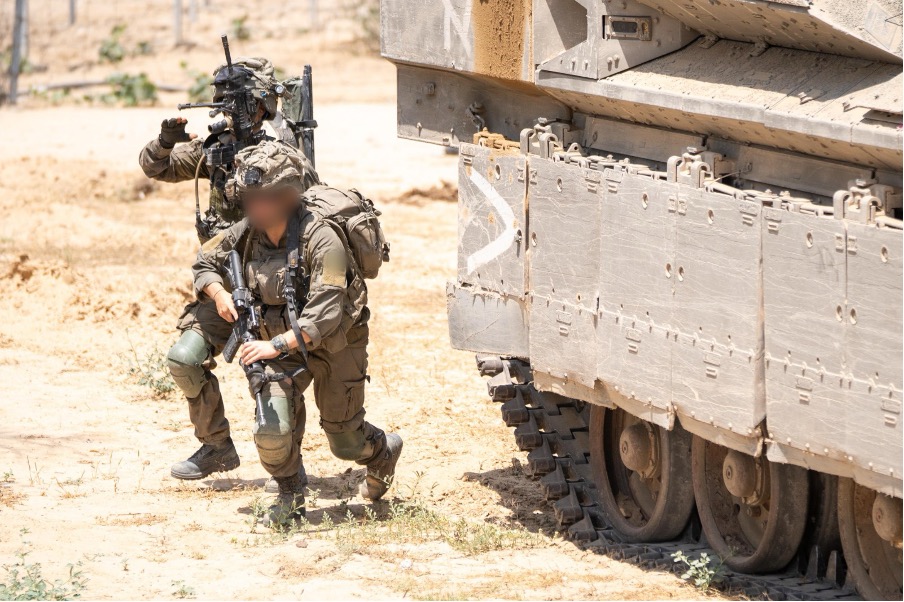
- Iranian President Pezeshkian, facing intense internal pressure just days ahead of the next round of Oman-hosted talks (where figures like Witkoff would be present), declared that Iran must respond forcefully to the attack.Pezeshkian’s message was not only for external consumption—warning Israel and the West—but also a signal to Iran’s own regime and public, emphasizing that failure to retaliate could destabilize the regime from within.
International Response and Diplomatic Dynamics
- Former US President Donald Trump stated that he had previously warned Iran about such a scenario, and cautioned that any further Israeli strikes could be “brutal.”He urged all sides to pursue a deal before events escalated beyond control.
- US Secretary of State Rubio publicly emphasized that Israel’s operation was conducted unilaterally, with the US not directly involved and focused on protecting American troops in the region.He noted, however, that the US was given advance notice of the operation, and affirmed US readiness to aid in Israel’s defense if necessary.
- President Trump also noted US preparedness to support Israel militarily, but underlined the expectation of further negotiations with Iran soon.At the same time, the International Atomic Energy Agency officially confirmed Iran’s ongoing violations of its nuclear commitments, framing the attack as a response to clear, ongoing provocations.
- US and Israeli media outlets have confirmed that the apparent public tension between Netanyahu and Trump over a potential strike on Iran was a calculated deception designed to deceive Iranian intelligence. While public statements projected opposition and warned of escalation, behind the scenes Trump and his advisers privately supported Israel’s actions and effectively gave a green light. The strategy aimed to lower Iran’s alert level, ensure key targets like IRGC leadership and nuclear scientists remained active and visible, and maximize the impact of the Israeli operation
- Speaker of the Iranian Parliament, Mohammad Qalibaf, issued an incendiary statementin response to Israel’s operation, declaring, “The time for revenge has come, and it will be carried out by all means.” He vowed that Iran would not abandon the issue of the “Zionist entity” and would see the confrontation through to its completion.
- Iran announced its withdrawal from nuclear negotiations with the United States.
- Reza Pahlavi, the son of Iran’s last Shah and a prominent opposition figure, issued a strong condemnation of the Iranian regime and its supreme leader, Ali Khamenei.He accused Khamenei of recklessly dragging Iran into a war that does not serve the nation or its people, but rather the interests of the Islamic Republic and its leadership.
Israeli Home Front and Political Messaging
- At the start of the attack, Israel’s Home Front Command issued an “extreme alert” to citizens via their mobile phones, warning of a potential pre-emptive Iranian strike.Sirens sounded in the Tel Aviv and Jerusalem regions—not due to actual missile fire, but to prepare the public and emphasize adherence to new emergency instructions.
- The head of Home Front Command publicly stated that Israel is facing “intense days ahead,” and urged every citizen to know the location of their nearest shelter. This messaging was aimed both at public readiness and as a deterrent to Iran and its proxies.
Analysis
- Israel’s successful execution of this operation demonstrates a new degree of independence and operational reach, even without direct US participation. For years, Israel regarded large-scale strikes on Iran as only possible with American support. Israel’s achievements on the battlefield during the Iron Swords War coupled with the current geopolitical environment, allowed Israel to plan and execute this operation largely on its own, revealing both new vulnerabilities in Iran and a new level of Israeli strategic autonomy.
- Regionally, Israel’s demonstration of deep-strike capabilities—and the resulting “decapitation” of Iran’s senior leadership—signals a major shift in the balance of deterrence. By projecting military power 1,500 kilometers from its borders, Israel has positioned itself as a hegemonic force capable of enforcing “red lines” across the Middle East, with implications for Lebanon, Syria, Iraq, and beyond.
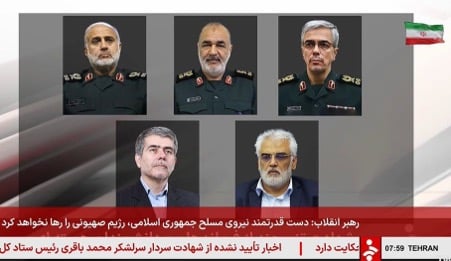
- Had this attack occurred before October 7, 2023, it would likely have triggered immediate, massive retaliation from Hezbollah and Palestinian factions, exploiting the so-called “rocket belt” threat. However, after nearly two years of war, Iranian defeat on multiple regional fronts, the destruction of Iran’s S-300 air defense batteries in earlier attacks, and the expansion of Israel’s own air force, Israel was able to conduct this operation with minimal external interference or immediate proxy backlash.
- The fact that Hezbollah, Iran’s closest and most powerful proxy, is now weakened, disarmed, and deprived of much of its senior leadership is a central factor in tipping the balance of power in the region. Unlike in previous years—when Hezbollah posed a formidable rocket threat and held sway over the “Axis of Resistance”—the group is currently incapable of mounting a coordinated or meaningful response against Israel. This represents a dramatic shift in the regional strategic environment. Iran’s vision of a “ring of fire” around Israel, has unraveled. Now, with Hezbollah debilitated and unable to act after it publicly announced it would not join the fight against Israel, Iran’s grand design is collapsing before its eyes, and Tehran is left paying the price for engineering a failed multi-theater war.
- Iran’s weakness is now resonating both regionally and internationally. For years, the prevailing wisdom was that Iran’s proxy groups drew their strength from the might of their patron in Tehran, with the ayatollah regime serving as the anchor of the so-called “resistance axis.” Iran’s vulnerability is now exposed and its isolation becomes more apparent. It is isolated by its allies- Russia’s reaction was tepid, while China’s was purely diplomatic, offering little in terms of practical support. The Sunni Arab states, especially those in the Gulf who have long feared Iranian and proxy aggression, issued superficial condemnations but in reality, welcomed Iran’s weakened state.
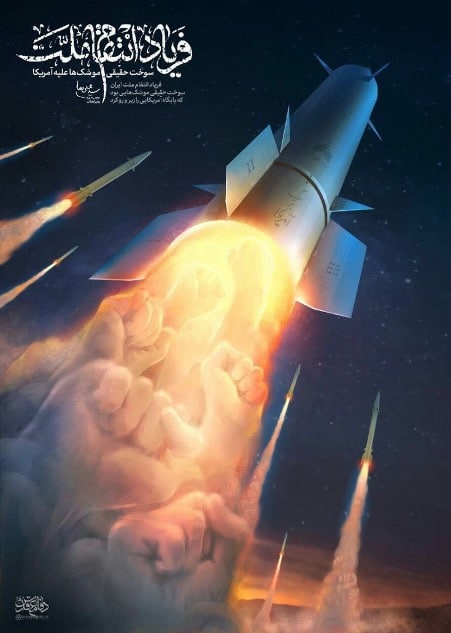
International
- Britain, Australia, Canada, Norway, and New Zealand imposed sanctions on Finance Minister Smotrich and National Security Minister Ben Gvir, accusing them ofincitement to violence against Palestinians. The two are banned from entering these countries, and financial institutions are forbidden to do business with them. Foreign Minister Sa’ar sharply criticized this decision.
- Secretary of State Rubio condemned these countries for imposing sanctions, arguing it does not help end the war or bring back hostages, and reminded them that no such sanctions have been imposed on Hamas or the Houthis.
- Pakistan has voiced full diplomatic and moral support for Iran, with its Foreign and Defense Ministers urging Muslim countries to unite against Israel. Islamabad has endorsed Iran’s “right to self-defense” while coordinating at diplomatic forums and offering potential military cooperation.
- North Korea continues to provide Iran with critical strategic support, including missile and nuclear technology transfers. Reports indicate that Iran is using North Korean designs in its developing “Haj Qassem” guided ballistic missiles.
- The “a‑Sumoud” convoy, comprised of over 1,000 activists in buses and cars from Algeria, Tunisia, and Libya, was heading toward the Rafah crossingto protest the war and get aid to Gaza. Egyptian authorities detained and deported hundreds of convoy participants at Cairo airport. They blocked access to Sinai, preventing the convoy’s progress
Gaza
Hostage Deal
A new ceasefire and hostage deal is being discussed: During a 60-day ceasefire, eight hostages would be released on the first day, and two more on day 60; the remains of deceased hostages would be returned in three phases.
There would be negotiations to end the war, with Trump and Witkoff expected to guarantee the ceasefire’s stability (since Hamas fears Israel might resume fighting immediately after the hostages’ release). The Israeli leadership is currently considering this proposal.
Operational
- Division 36 is advancing into the city of Khan Younis from the south, whileDivision 98 entered from the north. When the two divisions link up, the encirclement of the Khan Younis area will be complete.
- Following the interrogation of a captured militant by the Shin Bet,188th Brigade soldiers located a tunnel shaft that led to the bodies of two deceased hostages. One has been identified as Yair Yaakov, kidnapped from Nir Oz by Islamic Jihad and murdered in captivity; the name of the second has not yet been cleared for publication. The number of hostages in Gaza has now dropped to 53, of whom 20 are still alive.
- A Givati Reconnaissance Unitidentified two militants disguised as women carrying sacks from a building used by Hamas. The force directed an aircraft that struck and killed the two.
Humanitarian Aid
- 20 Gazans employed by GHF were on a bus returning from a distribution pointwhen a Hamas gang attacked them, killing 8 civilians, wounding others, and reportedly kidnapping several.
The Fund’s management stated this attack came after many threats, which had been ignored, and called on the international community to condemn Hamas. - Despite this attack, three aid distribution points were opened.
- With government approval, 56 aid trucks entered Gaza through a breach in the fence called “Zikim Crossing,” but these were quickly looted by crowds in Gaza City.
- Despite Hamas claims of civilian deaths and threats to prevent people from taking Israeli-supplied food at distribution points, crowds of Gazans continue to come, gradually contributing to the success of the new aid mechanism.
- Yasser Abu-Shababadmitted ongoing contacts with the Palestinian Authority (PA), especially with its Preventive Security Force, which actively fights PA rivals like Hamas.
He denied any connection to Abu Mazen but expressed respect for him as “the president.” Abu-Shabab stated at least 1,000 civilians arrived in eastern Rafah, that he receives thousands of requests to join the “Popular Forces” and to seek shelter, and expressed a desire to avoid further division in the Palestinian camp.
He admitted to cooperating with GHF and said that Hamas gangs are responsible for shooting at the distribution points. - Abu-Shabab formally announced the creation of an administrative alternative to Hamas called “Popular Forces”. Heinvited journalists, engineers, programmers, doctors, lawyers, and others to join them in eastern Rafah to build a new state and protect the dignity of the people, aiming to create the first administrative zone in Gaza without Hamas as a model for the rest of the Strip.
- Hamas’s “Saham” Unit(a kind of police commando responsible for securing food convoys and suppressing the population) claimed it captured an Abu-Shabab man in central Gaza who killed a Hamas member.
Domestic Israel
- A bill to dissolve the Knesset failed(61 against, 53 in favor). A new agreement was reached between Likud and the ultra-Orthodox parties: The goal is to draft 10,000 recruits within two years and half of each annual cohort within five years. Some sanctions will be approved, such as banning driver’s licenses and restricting travel abroad for draft evaders.
- This will allow the government tosurvive for at least six more months, enough time to finish the war.
- US Ambassador to Israel Mike Huckabee washolding talks with Haredi Knesset members and leading rabbis, to prevent the collapse of the government, as such a collapse would weaken the American position against Iran.
Judea and Samaria
Operational
- After 30 hours of operations in Nablus’s Kasbah, at least 10 wanted suspects were arrested, 2 militants were killed, and several weapons were confiscated after searches in 400 buildings.
Diplomatic
- PA President Abbas sent a letter to French President Macron, where hecriticized Hamas’s actions on October 7, supported removing Hamas from Gaza and disarming them, and called for the establishment of a Palestinian state.
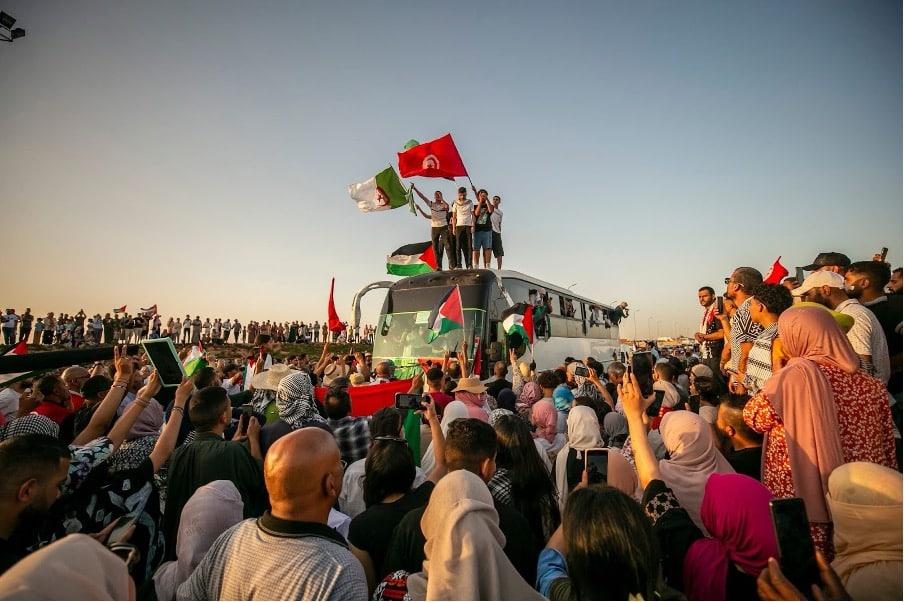
Lebanon
Diplomatic
- Following the Israeli strikes, Hezbollah issued a rare statement condemning Israel but stopped short of threatening to join the conflict or vowing retaliation—a break from previous practice. The Lebanese government, still recovering from the massive destruction and displacement pressured Hezbollah to avoid escalation.
- Hezbollah is shifting its strategy from relying on rockets and missiles to using drones (UAVs). With the maritime and air borders closed, and the land border with Syria blocked by continuous Syrian Border Guard and Lebanese security operations to prevent Iranian smuggling, Hezbollah has no choice but to move to local drone production.
- Drones are easier to produce domestically than rockets, and throughout the war, drone use—whether for attacks or surveillance—has proven more effective and harder to intercept than rockets.
Yemen
- The Houthis launched multiple missiles that were intercepted; some hit Palestinian homes. One missile fell on a Palestinian man’s house in Hebron, and on June 13, during the Iranian attacks, a Houthi missile hit a Palestinian town, injuring three Palestinians.
- Israel carried out its tenth attack against the Houthis, and for the first time, this was a naval strike. Sa’ar 6-class missile boats from the Israeli Navy struck Houthi ports with precision missiles from hundreds of kilometers away, launched from the northern Red Sea after long preparations in what is considered a precedent-setting attack.
Fallen Soldiers
